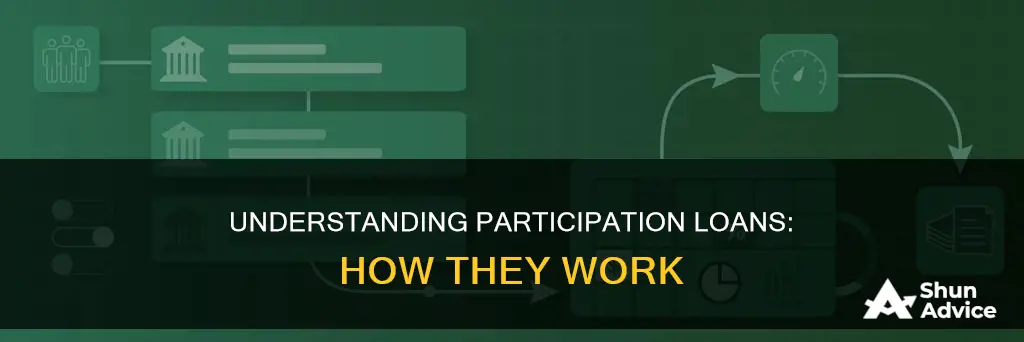
A participation loan is a type of lending arrangement where multiple lenders, such as banks or credit unions, come together to fund a single loan for a borrower. This is usually done when the loan amount is extremely large, and a single financial institution may not be able to provide the entire sum. In such cases, one of the lenders takes on the role of the lead bank and originates the loan, while the other participating institutions contribute their share of the funds. The lead bank then manages the loan servicing, organizes the participation, and directly interacts with the borrower. Loan participations can be structured in different ways, such as pari passu or senior/subordinated bases, each with distinct risk-sharing and payment priorities. This arrangement allows banks to diversify their assets, enhance liquidity, and manage credit risk.
Characteristics and Values of a Participation Loan
| Characteristics | Values |
|---|---|
| Number of lenders | Multiple lenders |
| Number of borrowers | Single borrower |
| Lead financial institution | The first lender to provide funds to the borrower |
| Role of lead financial institution | Originates the loan, services the loan, deals directly with the borrower, manages the participation, recruits other banks, and sells participations to other financial institutions |
| Nature of participation | Pari passu (equal risk sharing) or senior/subordinated basis |
| Nature of syndication | Multiple lenders contracting directly with a borrower under the same credit agreement |
| Nature of contractual relationship | Runs from borrower to lead bank and from lead bank to participants |
| Nature of agreement | Separate contract called a loan participation agreement structured and agreed upon among financial institutions |
| Nature of participants | Banks or credit unions |
| Purpose | To enhance liquidity, interest rate risk management, and capital and earnings; to diversify loan portfolio and serve credit needs of borrowers; to reduce credit risk to a specific community or customer; to remain within legal lending limits |
| Risk management | Each participant expected to maintain a robust risk management program |
What You'll Learn
- Loan participations are a sharing or selling of interests in a loan
- They are made by multiple lenders to a single borrower
- The lead bank originates the loan and manages the participation
- Loan participations can be made on a pari passu basis or a senior/subordinated basis
- Banks that buy loan participations share in the profits of the lead bank

Loan participations are a sharing or selling of interests in a loan
In a loan participation, the originating bank arranges the loan with the borrower and then sells a portion of it to participating banks or credit unions. The lead institution typically retains a partial interest in the loan, holds all loan documentation, and deals directly with the borrower. Loan participations allow the lead bank to originate an exceptionally large loan that would otherwise be too big to handle alone. By engaging other banks as participants, the lead bank can stay within its legal lending limits while still providing sufficient funding.
Participating banks benefit from loan participations by sharing in the profits of the lead bank and reducing their credit risk. By investing in loans in different locales, they diversify their assets and lower their exposure to potential losses in the event of a calamity or economic downturn affecting a specific community. However, it is important for purchasing banks to conduct their own due diligence, apply their underwriting standards, and carefully review loan agreements to make prudent decisions.
Loan participations and syndications are often confused as both involve multiple lenders. However, they are distinct types of transactions with unique accounting and legal considerations. In a loan syndication, each lender has a direct contractual relationship with the borrower and makes an individual lending agreement, whereas in a loan participation, the contractual relationship runs from the borrower to the lead bank and then from the lead bank to the participants.
Understanding WHEDA Loans: A Guide to Wisconsin's Loan Program
You may want to see also

They are made by multiple lenders to a single borrower
A participation loan is a loan made by multiple lenders to a single borrower. It is similar to a syndicated loan, but with some key differences. In a participation loan, each lender passes the funds to the lead financial institution, which then provides the loan to the borrower. This lead institution, often a bank, takes responsibility for the loan servicing, organizes and manages the participation, and deals directly with the borrower.
The lead bank typically originates the loan and retains a partial interest in it. It holds all the loan documentation and original documents, and it services the loan for the benefit of all participants. The lead bank will also recruit other banks to participate and share the risks and profits. The participation agreement will include the terms of the arrangement, including profit-sharing, loan fee-sharing, and the standard of care the lead lender owes to the participants.
Participations can be made on a pari passu basis, with equal risk-sharing for all participants, or on a senior/subordinated basis, where the senior lender is paid first, and the subordinate loan participant is only paid if there are sufficient funds remaining. This senior/subordinated structure can be organized on a LIFO (Last In First Out) or FIFO (First In, First Out) basis.
Loan participations allow the lead bank to originate an exceptionally large loan that would otherwise be too big for it to handle alone. By engaging other banks as participants, the lead bank can stay within its legal lending limits while still providing sufficient funding for the borrower. This also allows the participating banks to diversify their assets and reduce their risk exposure.
Exploring the Intriguing Space In Between
You may want to see also

The lead bank originates the loan and manages the participation
The lead bank will hold all the original documentation, including the deed of trust/mortgages, tax returns, and other documents. It will also service the loan, which includes invoicing participating banks for their share of legal fees in the event of loan foreclosures, and distributing pro-rata shares of net proceeds from the sale of collateral.
The lead bank will also be responsible for ongoing due diligence, which includes sending copies of pertinent documents to participating banks or credit unions. This may be facilitated by loan management systems.
The contractual relationship runs from the borrower to the lead bank, and then from the lead bank to the participants. The borrower may not know that the loan has been participated out to other lenders.
Understanding Loan Receivables: A Borrower's Perspective
You may want to see also

Loan participations can be made on a pari passu basis or a senior/subordinated basis
A participation loan is a loan made by multiple lenders to a single borrower. It is similar to a syndicated loan, but each lender passes the funds to the lead financial institution, which provides the loan to the borrower. The lead bank typically originates the loan, services it, and manages the participation. Loan participations are sold by the lead financial institution to other financial institutions.
The decision to structure a loan participation on a pari passu or senior/subordinated basis depends on the specific circumstances and relationships between the financial institutions involved. A pari passu basis may be preferred when the participating financial institutions have similar risk appetites and want to share the risks and rewards equally. In contrast, a senior/subordinated basis may be chosen when one financial institution wants to take on more risk and have priority in repayment, while the other prefers a more junior position.
By engaging in loan participations, banks can diversify their assets, reduce their risk, and generate more lending income. It allows them to invest in a variety of loans in different locales, reducing their exposure to potential losses in the event of a calamity or economic downturn affecting a specific community. Additionally, loan participations enable lead banks to originate exceptionally large loans that would otherwise be beyond their legal lending limits.
Who Owns Simple Fast Loans? Uncovering the Truth
You may want to see also

Banks that buy loan participations share in the profits of the lead bank
Banks that buy loan participations can share in the profits of the lead bank. This is because participation loans are loans made by multiple lenders to a single borrower. The lead bank originates the loan and recruits other banks to participate and share the risks and profits. This allows the lead bank to remain within its legal lending limits while still providing sufficient funding for the loan.
In a loan participation, the originating bank enters into several lending arrangements. The first transaction is a loan origination to the borrower, which follows normal loan accounting under ASC 310. The subsequent transaction involves the unloading of a portion of the loan to participating banks, which is considered a "transfer of a financial asset". This transaction must be assessed for derecognition under ASC 860 to determine if it represents a "participating interest" and if the originating bank has relinquished control.
The lead bank typically holds the loan documentation, services the loan, and deals directly with the borrower. The participation agreement includes terms such as profit-sharing, loan fee-sharing, and the standard of care owed to the participants. Banks that buy loan participations can benefit by diversifying their assets and reducing their exposure to potential losses in a specific community or market.
It is important to note that loan participations and syndications are different types of transactions with unique accounting and reporting considerations. In a loan syndication, the lead bank acts as a "syndicate", matching the borrower with multiple lenders, each of which underwrites a portion of the loan. In contrast, a loan participation may not involve a direct contractual relationship between the participating lenders and the borrower.
Becoming a Loan Signing Notary: A Step-by-Step Guide
You may want to see also
Frequently asked questions
A participation loan is a loan made by multiple lenders to a single borrower. It is similar to a syndicated loan, but each lender passes the funds to the lead financial institution, which provides the loan to the borrower.
A participation loan involves a borrower, a lead financial institution, and multiple participating lenders. The lead financial institution originates the loan and manages the participation, and the participating lenders provide funds to the lead institution.
Lenders participate in these loans to diversify their assets and reduce their risk. By investing in loans in different locales, they lower their exposure to potential losses from events like natural disasters or economic downturns affecting a specific community.
The lead financial institution benefits by being able to originate and approve large loans that would otherwise exceed its legal lending limits. By engaging other banks as participants, the lead institution can access sufficient funding while remaining within its regulatory boundaries.







